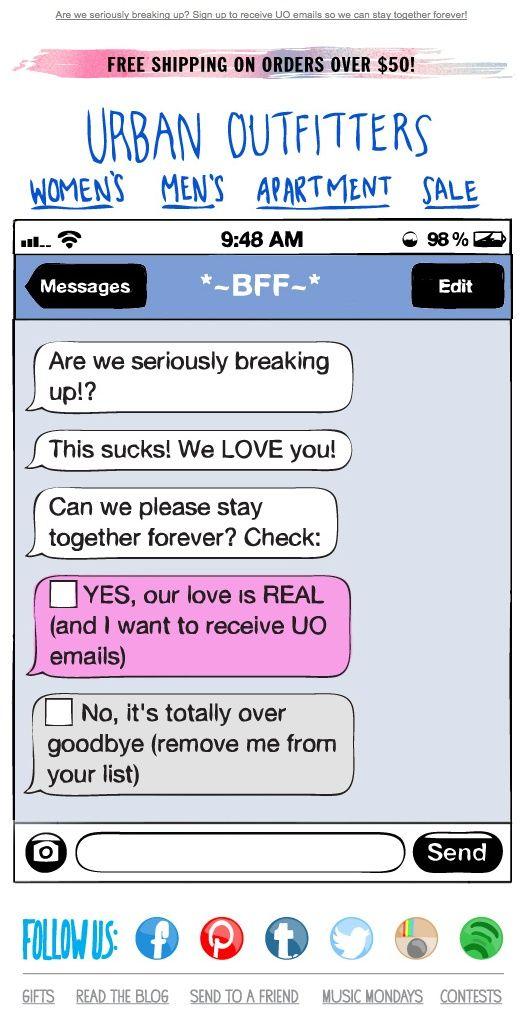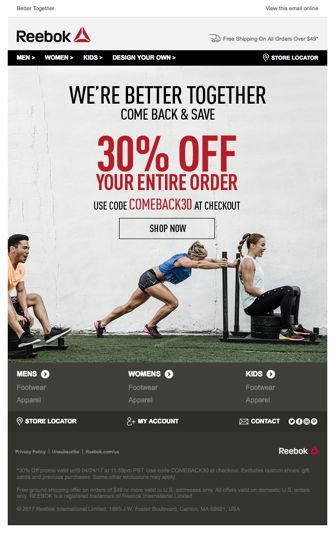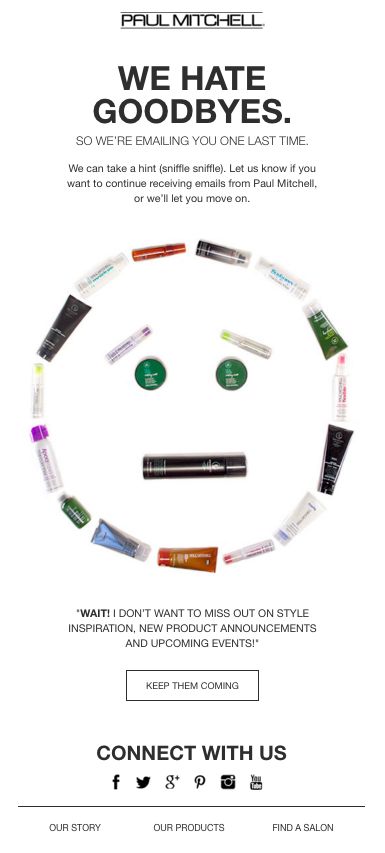As marketers, we look at the communications we make through rose-colored lenses. Honestly, who could blame us? We dig tirelessly for insights, carefully craft strategic approaches, painstakingly construct authentic messaging and refine round after round of creative revisions to ensure a result that’s note perfect. The final product is a carefully packaged email bursting with relevancy and value for some lucky recipient on the other end.
But after all the love we pour into the process, some customers just won’t open their emails.
This presents a problem that’s two-fold; the obvious first issue being a lack of communication with a valued customer, and the second being the cost and efficiency of managing a bloated email distribution list. To combat the second problem, email service providers will generally prescribe a defined amount of time in which an addressee must open an email or they risk being placed on a Do Not Email (DNE) list. These times can vary, but usually average 9 – 15 months [i]. Once that occurs, the ability to email those addresses is gone forever.
The cost of acquiring a new customer vastly outweighs the cost of replacing the ones you already have.
So, what’s the answer? Do you passively sit back, accept fate and let them fade quietly into that good night? Or should you continue to throw bottles into the ocean, hoping against hope?
According to Sting, “If you love somebody, set them free.” If you’re a Bon Jovi disciple, “We gotta hold on to what we got.” Disparate theologies depending on the church you go to for worship, but what is the right tactic to reengage dormant customers? Turns out, it’s a bit of both.
First, you must understand the potential root causes for this disconnect.
Barriers to customers opening brand emails
Simply unaware they are getting them: This can often be the case with brands that automatically populate brand email addresses for their customers upon registration/activation. 38 percent of U.S. consumers report having multiple email accounts. [ii] Depending on the provider, messages deemed as marketing can often be squirreled away in a spam folder. If communication preferences are never updated, those mailboxes can quickly turn into a repository for your forgotten messages.
Inbox fatigue: 45 percent of customers that opt out of brand communications cite email frequency as the reason they left[iii]. If your communication cadence resembles a game of Whack-a-Mole, who can blame them? Understand that people need space from brands in the same way they do from their significant others.
Emails are perceived as redundant, or worse, not relevant: They don’t see the value in opening. “I’ve already gotten 3 of these this week” or “They’re just probably trying to sell me something.”
Solutions to drive customer re-engagement
Attack those barriers! Be an advocate for the customer experience!
Fish in the right pond: Knowing that the average person carries multiple email accounts, there are third-party data vendors that have vast repositories of available email addresses. Using their proprietary algorithms, they can provide account match-backs with a high degree of certainty. This extends reach across multiple inboxes increasing the probability of reaching the customer.
Personalize and get their attention: Be direct in the subject line. With people warily scanning their inboxes avoiding spam and sales messages, shoot straight and with purpose. People care about information that can potentially affect their accounts.
Subject line: Stress individual relevancy through personalization tinged with a sense of urgency.
Dear [NAME], we have important information about your account.
Authentic creative and transparent messaging: So, they’ve opened the email, now what? Speak to them honestly. Acknowledge those commonly held pain points. Some brands use humor, some express sadness, and others speak very bluntly. Whichever route you choose, BE AUTHENTIC. If your brand voice has never incorporated humor, this should not be the first time to try out a new set!

Give the power back: Brands should develop a path for customers to self-identify communication preference. This not only empowers them with a sense of control, it also helps identify the desired frequency, message hierarchy and channels they wish to engage in.

Give them a reason to stay: If they haven’t opened an email in a while, then they probably don’t have awareness of all the benefits and value embedded in their brand communications. That can be offers and discounts, the benefits of a loyalty program, extended security features, new innovations from the brand or social outreach in the community. Let them know what they’re missing, and the value being left on the table when their emails are left unopened.
Messaging: Underline the value and personal benefits available to them specifically.
Are you getting all the benefits you deserve?
Make sure you’re not missing out on all the discounts available to you.

Provide a sense of urgency: If they don’t respond in the allotted time, they WILL be removed from those email distribution lists. This should not to be heavy handed or accusatory. Acknowledge those known pain points. Be understanding and position it as trying to provide the best customer experience possible.
Urgency: We want to provide them the best customer experience, whatever that may be for them. Why wait? Give them a choice.
We get it, inboxes be crazy these days. If you’d like to continue receiving emails, please provide your preferred email.
We want to make sure we’re not bothering you. Please provide your preferred email by XX if you want to continue to receive communications from us.

Reinforcing the choice to stay
For customers who have returned to the fold, consider the potential reasons they left in the first place. Their first communications from the brand shouldn’t ask anything of them. Rather this communication should be rooted in appreciation and extend something of real value. These customers should not be plunged immediately back into the main marketing stream. Instead, reintroduce them gently with a customized 2 – 3 touch stream that removes sales messaging and focuses exclusively on the relevant benefits available to them. Get them engaged with loyalty programs when applicable. Gift them rewards to incentivize that engagement. Extend real value through product and service discounts. Let them know that you appreciate them and value their business.
Lastly, construct this communication solely around them. This isn’t an opportunity for the brand to chest thump. Show them benefits that create real tangible everyday value for THEM. Show them that they are an appreciated and valued part of the family.
Use the creative to spark engagement. This is the marketing equivalent of John Cusack with a boombox outstretched over his head at the end of “Say Anything.” Don't be afraid to put your heart on the line. Customers recognize authenticity when they see it.
ROI
“Creative without strategy is called art. Creative with strategy is called advertising.” [iv] We all understand what strategically targeted creative can deliver, but is it capable of breaking through to drive real ROI with this unique customer segment?
In a recent execution, Javelin leveraged third-party email match-backs to selectively target a list of customers at risk of being lost to a DNE list based on a long history of not opening brand emails.
It was an approach that leveraged a recent creative redesign of brand communications along with an updated tone and tenor. By blending direct transparency with personalization, we presented these customers with a tailor-made suite of benefits designed specifically with them in mind.
What came back surpassed expectations.
Customers responded with a 36 percent open rate with a unique click through rate of 7.8 percent. Only .03 percent chose to opt out. Remember, these were customers that hadn’t opened an email from the brand in up to a year.
After opening the initial email, these customers were then placed in a two-touch stream designed to highlight personal relevancy through increased awareness of customer appreciation programs, service discounts and other benefits specific to their geographical footprint.
But the goal was not to get these customers to open one email. The goal was to reengage them with the brand. How would they respond when messaged again?
The second touch featured the customer appreciation program and the specific benefits available to the recipient.
It performed as well, with a 40.1 percent open rate and 3.97 percent click to open rate. Opt outs came in at .06 percent.
Conclusion
Your customers intuitively understand the nature of their relationships with corporate America. Brands are going to periodically try and sell them things. They expect that. What they demand in return is a fair exchange of value.
Customers are the life blood of your brand. If they’ve wandered off into the wilderness, don’t just mourn their loss; light a lantern and show them the path back.
Remind them of why they chose the brand in the first place.
Show them the appreciation they deserve.
Give them something unexpected.
Provide them a reason to stay, and they will.
[i] Source: Spamhaus, https://www.campaignmonitor.com/blog/email-marketing/2018/03/email-blacklists-101-what-you-need-to-know/
[ii] Source: https://www.west.com/blog/interactive-services/consumers-expect-brand-communication/
[iii] Source: https://www.statista.com/statistics/267738/number-of-email-addresses-usa/
[iv] Source: https://static1.squarespace.com/static/556bacd8e4b0a9228e32746b/t/5573da2ee4b0573e63484ee8/1433655854019/MaeveCreativeAdEssay.pdf




